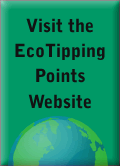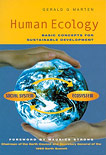Human Ecology - Basic Concepts for Sustainable Development

Environmental success stories from around the world with their lessons on how to turn from decline to restoration and sustainability.
Author: Gerald G. Marten
Publisher: Earthscan Publications
Publication Date: November 2001, 256 pp.
Paperback ISBN: 1853837148
Hardback SBN: 185383713X
Information for purchasing this book:
United States/Canada - Stylus Publishing
Elsewhere - Earthscan Publications
Japanese version - Amazon Japan
Back to Human Ecology - Table of Contents
Preface
Twenty years ago I worked with a network of agronomists, social scientists and ecologists in South-East Asia. The agronomists were using Green Revolution technology to develop new production systems for small-scale agriculture in the region. Change was essential to feed a growing population. The new methods offered impressive possibilities for increasing food production and farmer incomes but in many instances the farmers were not using them. The agronomists were understandably disappointed and sought the help of social science colleagues to find out what they could do to convince farmers to take advantage of the opportunities.
The social scientists spent a lot of time talking to farmers and soon discovered that the farmers were generally more innovative than conservative. Many routinely experimented with new crops and cultivation techniques in a corner of their farm, adopting them on a larger scale when it was apparent they would do well. The farmers knew from experience that new crop varieties frequently did not perform so well on the marginal land that many of them had to use. Even if the land were suitable, improved varieties would require an ample water supply and expensive inputs such as fertilizers and pesticides in order to achieve high yields, inputs which were beyond the means of many poor farmers. The farmers were also afraid that new cultivation methods could lead to unanticipated long-term problems that they did not have the resources to deal with. Their apprehensions turned out to be justified, as soil problems appeared after several years in some areas with new agricultural systems. Most farmers felt they could not afford to make irreversible mistakes because they had no alternatives for earning a living besides their farms.
As the agronomists and social scientists learned more from the farmers, they came to appreciate how important it was for the new agricultural technology to fit into the everyday realities of the farmers’ lives and how important it was for it to be ecologically sustainable. They also discovered that they had much to learn from the farmers’ traditional agricultural methods, which had proved ecologically sustainable for centuries. All of this made the agronomists realize they would be more successful working with a broader perspective than in the past. The result was a collaborative research network of agronomists, social scientists, ecologists and farmers, each of which had something to contribute to the task of developing agriculture that farmers really could use.
This story illustrates just one of the thousands of challenges facing humanity as economies, technologies, cultures and the ways that people use natural resources change in today’s rapidly evolving world. These challenges are encapsulated by the concept of ‘sustainable development’, frequently defined as meeting the needs of the present without compromising the ability of future generations to meet their own needs. Some consider sustainable development to be the major challenge of our time, but it is difficult for concerned individuals to know what they can actually do to help make it happen.
Human ecology, the science of interrelationships between people and the environment, can help to sharpen our perceptions of what is happening with the environment, and how people and the environment function together. This kind of understanding is one essential step toward effective action.
The term ‘human ecology’ has a long and varied history. It was first used in the 1920s, when a small group of urban sociologists used ecological concepts to explain what they were observing in cities. The sociologists found ecological metaphors to be of use because some of the early ecological concepts were in fact general systems concepts that were also valid for human society. This form of human ecology, which was prominent until the 1970s, was totally different from the human ecology in this book.
In the 1960s and 1970s, biological ecologists who were alarmed by the human population explosion and its implications for environmental destruction used the term ‘human ecology’ to emphasize that humans are subject to the same ecological limitations as other animals. At the same time, anthropologists directed attention to the shaping of culture by environment, and some anthropologists initiated human ecology field studies using prominent ecological concepts of the time, such as population regulation and energy flow. As awareness of environmental problems increased during the 1970s, scholars in a diversity of academic disciplines began to speak of ‘human ecology’. These different forms of human ecology, conforming to the different disciplines in which they arose, generally had little in common with one another beyond dealing with people and the environment.
By the 1980s, biological ecologists and social scientists were working together in multidisciplinary research teams addressing practical problems involving the environment. For many of these scientists, including myself, human ecology was a perspective for problem solving that focused on interactions between human societies and the environment. By tracing chains of effects through ecosystems and human society, and by understanding more generally how people interact with ecosystems, human ecology could help to:
- anticipate the long-range environmental consequences of human actions;
- avoid disastrous surprises from the environment;
- generate ideas for dealing with environmental problems; and, in general,
- maintain a liveable and sustainable relationship with the environment.
The number of scientists studying human - environment interaction increased over the years, and the diversity of their backgrounds and perspectives expanded correspondingly.
This book grew out of an undergraduate course in the School of Policy Studies at Kwansei Gakuin University in Japan. The purpose of the course was to offer students a conceptual foundation for making human ecology and sustainable development an integral part of their personal and professional lives. The book reflects my own view of human ecology and attempts to provide a clear, understandable and coherent system of concepts for comprehending how ecosystems function and how human societies interact with ecosystems. The book draws on a variety of existing ideas, integrating long-standing ecological principles with concepts assembled more recently under the rubric of complex systems theory. The last part of the book focuses on social processes, social institutions and technologies that conflict with, or contribute to, ecologically sustainable development. While I hope this book will see extensive use in the classroom, it will be of equal value to anyone who is concerned about the environment and seeks the kind of understanding that can help to do things that make a positive difference.
Most of the concepts in this book are firmly established but a few are still the subject of unresolved scientific debates. One example is the concept of emergent properties (introduced in Chapter 4). Some scientists, including myself, consider each level of biological organization to have ‘a life of its own’ that emerges from the organization of the parts rather than simply from the characteristics of the parts themselves. Other scientists consider emergent properties to be theoretical constructs that lack rigorous scientific confirmation. I use emergent properties because they encourage the kind of whole-system thinking that I consider essential for ecologically sustainable development.
The concepts in this book are communicated by means of examples and stories, often accompanied by diagrams. I have sometimes used a ‘broad brush’ approach in the examples as the focus is on communicating the concepts rather than analysing particular situations in detail. The book includes a list of Further Reading which provides readers with the opportunity to explore central concepts and key examples in greater detail. It also offers an opportunity to explore details and perspectives of human ecology that are not covered in depth in this book.
A full appreciation of human ecology comes only with exploring the details of human - environment interaction in specific cases. The ‘Things to Think About’ exercises at the end of each chapter are intended to stimulate concrete translations of concepts to the reader’s own circumstances. Reports in the annual State of the World and Worldwatch Paper series (Worldwatch Institute, Washington, DC) are valuable sources of information for some of these exercises. To realize the fullest benefits, readers should develop their own examples - their own ‘stories’ - in as much detail as possible. In that way, human ecology will come to life, and readers will begin to develop concrete visions of the possibilities for ecologically sustainable development in their own community.
Technical terms, as well as words used somewhat differently from their general meaning, are presented in bold type the first time they appear in the text. Their meanings are explained in the glossary.
